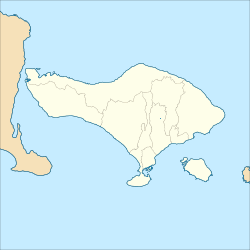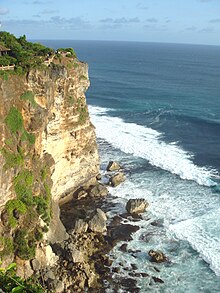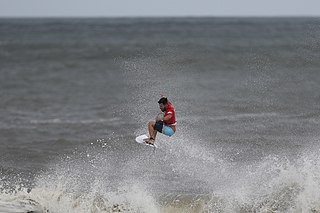
Surfing is a surface water sport in which an individual, a surfer, uses a board to ride on the forward section, or face, of a moving wave of water, which usually carries the surfer towards the shore. Waves suitable for surfing are primarily found on ocean shores, but can also be found as standing waves in the open ocean, in lakes, in rivers in the form of a tidal bore, or in wave pools.
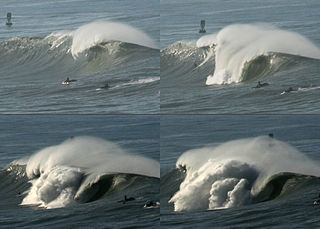
Mavericks is a surfing location in northern California outside Pillar Point Harbor, just north of the town of Half Moon Bay at the village of Princeton-by-the-Sea. After a strong winter storm in the northern Pacific Ocean, waves can routinely crest at over 25 ft (8 m) and top out at over 60 ft (18 m). Routinely, waves that break can be recorded on seismometers. The break is caused by an unusually shaped underwater rock formation.
Rincon(Spanish, "angle" or "corner") is a surf spot located at the Ventura and Santa Barbara County line in Southern California, United States. Also known as the "Queen of the Coast", Rincon is one of the most famous surf spots in California, known around the world for its well-formed waves and long rides. The book 100 Best Surf Spots in the World rates Rincon at 24. It is best at low tide during the winter months when swells are coming mostly from the west and northwest. There is a gated residential community that occupies most of the Rincon beachfront. Public access is provided at parking lots on both sides of the gated community, with restrooms and a picnic area in the upper parking lot, Rincon Beach Park.

The Banzai Pipeline, or simply Pipeline or Pipe, is a surf reef break located in Hawaii, off Ehukai Beach Park in Pupukea on O'ahu's North Shore. A reef break is an area in the ocean where waves start to break once they reach the shallows of a reef. Pipeline is known for huge waves that break in shallow water just above a sharp and cavernous reef, forming large, hollow, thick curls of water that surfers can tube ride. There are three reefs at Pipeline in progressively deeper water farther out to sea that activate according to the increasing size of approaching ocean swells.
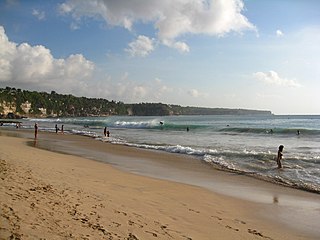
Dreamland Beach, now officially known as New Kuta Beach, is a beach located in Pecatu on the Bukit Peninsula on the island of Bali, Indonesia. A popular surfing beach, it was formerly secluded and had casual refreshment stands and inns. It has since become the beach of an extensive tourist development.
Morning of the Earth is a 1971 classic surf film by Alby Falzon and David Elfick.
G-Land, also known as Plengkung Beach, is an internationally renowned surf break on Grajagan Bay, Banyuwangi, Alas Purwo National Park, East Java, Indonesia, about half a day by road from the popular tourist destinations of Bali. It is most commonly reached via boat charter from Bali.
Bombora is an indigenous Australian term for an area of large sea waves breaking over a shallow area such as a submerged rock shelf, reef, or sand bank that is located some distance from the shoreline and beach surf break. In slang, it is also called a bommie.

Swami's is an area in San Diego County that contains Swami's Beach and other local attractions. The beach, also known as "Swami’s Reef'" and "Swamis", is an internationally known surfing spot, a point break located in Encinitas, San Diego County, California. Swami's was named after Swami Paramahansa Yogananda, because the grounds and hermitage of the Self-Realization Fellowship ashram, built in 1937, overlook this reef point. The name "Swami's" is also given to the sand beach that extends south from the point to the next beach access point, which is next to the San Elijo State Beach camping area; this more southerly surf spot often goes by the name "Pipes".

Encuentro Beach is an isolated stretch of beach in the Puerto Plata province of the Dominican Republic. Located between the more heavily populated cities of Sosúa and Cabarete this popular surfing beach is accessible to the public via dirt roads.

A surf break is a permanent obstruction such as a coral reef, rock, shoal, or headland that causes a wave to break, forming a barreling wave or other wave that can be surfed, before it eventually collapses. The topography of the seabed determines the shape of the wave and type of break. Since shoals can change size and location, affecting the break, it takes commitment and skill to find good breaks. Some surf breaks are quite dangerous, since the surfer can collide with a reef or rocks below the water.

This glossary of surfing includes some of the extensive vocabulary used to describe various aspects of the sport of surfing as described in literature on the subject.[a][b] In some cases terms have spread to a wider cultural use. These terms were originally coined by people who were directly involved in the sport of surfing.
Nembrala or Nemberala is a village (desa) on Rote Island, in Rote Barat district, Rote Ndao regency, East Nusa Tenggara province, Indonesia.
Shipstern Bluff is a globally renowned big-wave surfing location on the southeastern coast of Tasmania, Australia, on the Tasman Peninsula.

Pecatu is a village (desa) in South Kuta, Bali, Indonesia. Located in the western side of the Bukit Peninsula, its hilly landscape creates smaller, more isolated beaches than at Nusa Dua on the eastern side of the peninsula. It is popular with surfers and also with nudists. The Uluwatu Temple is also located at Pecatu.

Teahupoʻo is a village on the southeastern coast of the island of Tahiti in French Polynesia, France, in the southern Pacific Ocean. It is known for the large, consistent surf that occurs off its shore, and resulting international surfing competitions.
Kim Bradley was an Australian surfer that pioneered surfing competitions on the island of Bali, organizing the first one in 1979. He converted to Hinduism during his time in Bali.

Cowaramup Bombora is a big wave open-ocean surf break found on the south-west coast of Western Australia. It is located 2 km (1.2 mi) offshore west of Gracetown which is near the town of Margaret River, world-renowned for its surf, and is 265 km (165 mi) south of the capital city Perth.

Introduced to Indonesia in the 1930s, surfing now attracts both Indonesian and foreign surfers to numerous locations across the nation.
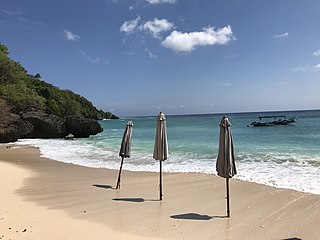
Padang Padang Beach is a 110-metre-long (120 yd) sandy beach in Pecatu on the Bukit Peninsula in Bali, Indonesia. It is characterised by fine white sand and tall cliffs.

